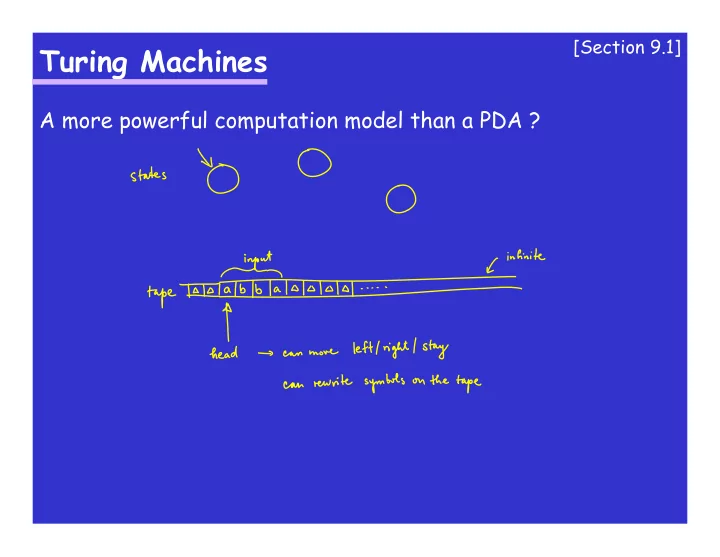

[Section 9.1] Turing Machines A more powerful computation model than a PDA ?
[Section 9.1] Turing Machines Some history: - introduced by Alan Turing in 1936 - models a “human computer” (human writes/rewrites symbols on a sheet of paper, the human’s state of mind changes based on what s/he has seen) - a reasonable model for real computers Church-Turing Thesis: For any problem L (given by a language) there exists an algorithm iff there exists a Turing machine which terminates on every input.
[Section 9.1] Real-world problems vs. languages Example : the airline problem - given are airports and available flights, is it possible to get from a place A to a place B ?
[Section 9.1] Turing Machines cont. Verbal explanation: - The tape is infinite to the right and it initially contains the input string (the rest of the tape contains blanks - M ). - The TM starts in an initial state, reading the first symbol on the tape. - The head can move left, right, or stay at its current position. - The TM has two special states, h a (accept) and h r (reject). - If the head moves to the left of the first symbol, this automatically means the change of state to h r (reject). - The transition is specified by a state and a tape symbol (to which the head points). It returns a new state, new tape symbol (to rewrite the original), and a head-move (L/R/S).
[Section 9.1] Turing Machines cont. Example : As a warm-up, give a Turing machine for a*b*c* Simplified transition diagram : we do not have to draw transitions leading to h r .
[Section 9.1] Turing Machines cont. A Turing machine (TM) is a 5-tuple (Q, Σ , Γ ,q 0 , δ ) where - Q is a finite set of states not containing h a , h r (the two halting states ) - is a finite alphabet (input symbols) Σ - is a finite alphabet ( tape symbols ) such that Σ ⊆ Γ and Γ Γ does not contain M (the blank symbol) - q o ∈ Q is the initial state - δ : ___________ → _______________________ is a partial function defining the transitions
[Section 9.1] Turing Machines cont. Let T = (Q, Σ , Γ ,q 0 , δ ) be a TM. A configuration of T is ________________. The initial configuration is ________________. We use ` T to say that T can get from one configuration to another configuration using a single transition. * to say that T can get from one configuration to We use ` T another configuration using a sequence of transitions.
[Section 9.1] Turing Machines cont. Let T = (Q, Σ , Γ ,q 0 , δ ) be a TM and x ∈ Σ * . We say that x is accepted by T if _____________________ . The language accepted by T , denoted L(T), is the set of all strings in Σ * that are accepted by T. A string x can be reject ed in two ways : either the computation of T on x ends in the state h r , or the computation of T on x gets into an infinite loop. A language accepted by a TM is called recursively enumerable . A language for which there is a TM which never goes to an infinite loop is called recursive .
[Section 9.1] Turing Machines cont. Example: Give a TM accepting { a k b k c k | k ≥ 0 }.
[Section 9.2] Turing Machines and functions Let T = (Q, Σ , Γ ,q 0 , δ ) be a TM and let f be a total function from Σ * to Γ * . We say that T computes f if for every x ∈ Σ * , * (h a , M f(x)). (q 0 , M x) ` T Example : give a TM that computes the function f(1 n ) = 1 2n
[Section 9.4] A stronger machine than a TM ? Possible attempts to make Turing machines stronger : - 2-way infinite tape - several heads, several tapes - random access (the head can jump to any position) - nondeterminism - etc. Note: All of the above changes can be simulated by a TM.
[Section 9.4] A stronger machine than a TM ? Example : How to simulate a 2-way infinite tape using a regular TM ?
[Section 9.5] Nondeterministic TM (NTM) The definition is the same as Turing machines, except that the transition function goes from Q × ( Γ ∪ { M }) to subsets of (Q ∪ {h a ,h r }) × ( Γ ∪ { M }) × {R,L,S}. Thm : Let T 1 be an NTM. Then there exist a TM T 2 such that L(T 1 )=L(T 2 ).
Recommend
More recommend